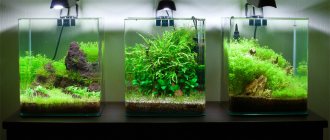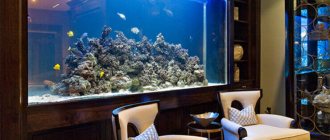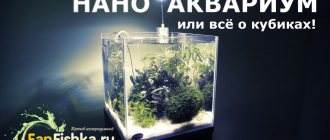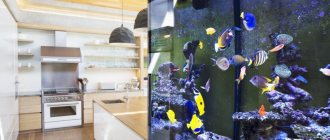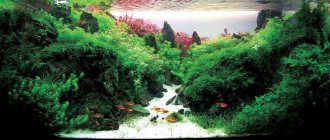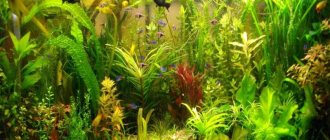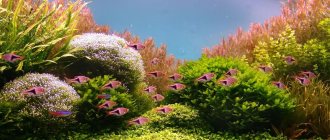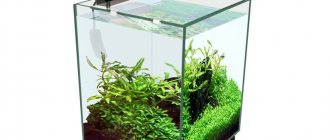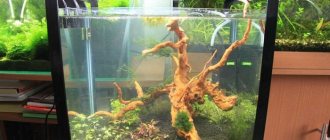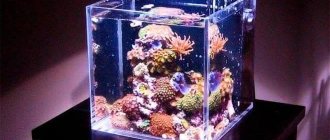5
(4)
Recently, nano aquariums have become an innovation in the aquarium world. This is a separate type of art for which special decorations are created, plants are grown and fish breeds are bred. This trend has captured amateurs and professionals from all over the world and has become incredibly popular.
What is a nano aquarium?
Nano aquarium - this term is now heard by all aquarists. Plants for a nano aquarium and fish for a nano aquarium are now sold separately. But what does this term actually mean, let’s figure it out.
Everyone knows what “nano” is, since nanotechnology appeared, everyone knows it - something small. So the expression nano aquarium originally referred to a miniature sea in an aquarium - a reef. The fact is that marine aquariums are usually extremely large, with live corals, anemones, other invertebrates sitting motionless, and, of course, fish. And when marine aquariums with a volume of less than 300 liters began to be created, they began to be called “micro-reefs,” that is, small reefs. When amateur aquarists began to produce the sea in even smaller volumes, 100 liters or less, they began to call them “nano-reefs” - that is, even smaller.
However, nowadays, when we talk about a nano aquarium, we are usually talking about a freshwater aquarium, and we mean small volumes - less than 40 liters. Although others say that a nano aquarium indicates the size of relatively large volumes. For example, to keep goldfish you need an aquarium volume of at least 100 liters, and if you keep it in a 10-liter aquarium, then it already becomes nano.
And yet, usually a tropical freshwater aquarium with a volume of 5 - 10 - 20 - 30 - 35 liters or a marine aquarium with a volume of up to 100 liters is now considered a nano aquarium. And when they talk about plants or fish for a nano aquarium, they mean the ability to keep them in this volume.
Although aquarium shrimp are most often kept in volumes of less than 30 liters, small fish are very rarely kept. But still, fish need more space, even small ones - 30 - 40 liters.
Today on sale there are special aquariums made of high-quality and ultra-transparent glass with a volume of 10 - 20 - 30 liters from Aquael and Dennerle, only a container with a substrate or complete with the necessary equipment: a lamp, a filter and even soil.
These aquariums are truly amazing, looking through glass of this quality is a pleasure, you will enjoy it every day. And aquadesigners sometimes create truly corners of nature, small imitation of the environment, in such small volumes. Iwagumi styles, jungle, natural design, using driftwood and rock fragments. Most often, their inhabitants are shrimp, neocaridins or red crystals. These nano aquariums are especially good if you want to use nutrient soil in them - you will need very little of it, up to 4 kg.
Launch rules
The nano aquarium is started in the following sequence:
- Soil 2-4 cm thick is laid at the bottom of the tank so that vegetation can grow and develop.
- Place decorative items: stones, driftwood and other decorations. Decorative elements must be treated before immersion.
- Living vegetation is planted following planting rules.
- The container is filled with settled water.
- Install the necessary equipment: filter, aerator, lamps, heater.
- Attach the reservoir cover (if equipped).
Having completed the above steps according to the step-by-step instructions for starting an aquarium from scratch, the aquatic environment is tested for suitability for fish life. If the indicators are normal, then the previously selected pets are released into the aquarium.
Nano aquariums are the best solution for those who have long dreamed of having a pond with fish, but due to limited space cannot afford a large tank. A miniature artificial pond is easy to care for, and colorful fish and live plants will help create a full-fledged imitation of underwater depths.
Equipment selection
Obviously, you need to choose equipment taking into account the size of the aquarium. One of the most common options is 8, 20 or 40 liter containers, which can be purchased at any pet store. Finding a filter for such aquariums is not difficult, since if necessary, you can take several external filters that will perfectly purify the water. Also, if you search, you can find other options for small aquariums and containers. A more serious problem is the selection of lighting systems.
Most pre-made aquarium covers do not provide enough light for healthy plants to grow. For a 40-liter aquarium, you can buy a standard lid and screw compact fluorescent lamps into it. You can read about how best to do this on the Internet. For small aquariums, choose compact fluorescent table lamps with a rotary handle. These lamps can be purchased at any hardware store.
They will provide enough light for tanks up to 20 liters, and the amount of light can be adjusted by changing the height of the lamp above the aquarium. But if you would like to get a better and more beautiful aquarium, you will have to fork out some money. Several major manufacturers offer fully equipped nanoaquariums, which already have all the necessary lamps and filters.
These aquariums use good quality glass or seamless acrylic fiber to ensure that nothing can spoil the look of your underwater garden. If you decide to purchase one of these systems, make sure that the lighting will be sufficient for growing plants (minimum 2-3 watts per 3-4 liters).
There are also some specialized stores that sell small containers for aquaculture from the Far East. The price range for these aquariums is quite wide. So you can choose from inexpensive to exclusive options with an open top, seamless walls and excellent glass quality. Some aquariums are sold with a filter and lighting fixtures, while for other tanks you will have to purchase additional equipment. Before you go shopping, we advise you to look at online stores. It is quite possible that even with delivery, such a purchase will cost less. Aquarium in nanostyle (ill. UncleX; aquascapingworld.com)
If you plan to add tropical fish or shrimp to your aquarium, then in most cases you will have to buy a heater. A good option is a small immersion heater with a built-in thermostat. Nowadays you can find heaters that fit perfectly even in 8-liter containers. Unfortunately, you are unlikely to find good heater options for smaller aquariums. Don’t ignore other containers that could serve as a nano aquarium. Large flat vases can make a charming water garden.
Some people plant aquaculture in Petri dishes and even inside a regular light bulb! Of course, such small containers are unsuitable for fish, but there are also advantages: you don’t need to worry about filtration and heaters. For a nano aquarium, it is quite possible to choose plants that will not require additional CO2. But with the supply of CO2, a world of very interesting plants will open up before you. If you have a CO2 system in large aquariums, then you will undoubtedly want one for your nano aquarium. If you haven't tried a carbon dioxide system yet, a nano aquarium is the place to start experimenting. Chances are, once you try this system, you'll be completely transformed!
Equipment
A significant part of the design is considered to be the equipment for the aquarium. Due to the small capacity, the ecological system is in limbo, so it is extremely important to choose high-quality equipment that will provide conditions suitable for the life of fish and plants. To properly start a pond, the owner will need:
- Filter.
- An aerator that provides oxygen to the aquarium.
- Ultraviolet lamp for the aquarium.
- Heater.
- Lighting.
A filter for a nano aquarium is selected based on the dimensions of the container. For vessels with small capacity, mechanical cleaning devices are used; the use of external filters for a nano aquarium will be relevant if the capacity is less than 30 liters.
Flaws
The nano aquarium has one very big drawback: instability. In such a small volume it is very difficult to maintain stable water parameters. Therefore, it is highly not recommended for beginners to start nano aquariums. Most beginners will encounter problems such as population loss (in both saltwater and freshwater aquariums) and the regular appearance of algae. Why is this happening.
pH – The small volume of water in a nano aquarium makes it prone to pH fluctuations. The dissolution of organic matter - animal waste, dead plants, all of this can lead to a drop in pH, especially in a new, freshly started aquarium that is only a couple of months old. Also, the lack of regular weekly water changes or overfeeding the fish (beginners very often simply do not know about water changes, and it is also common for them to overfeed animals) can lower the pH to a dangerous level. All this leads to excessive stress on the mini-eco system, which will lead to the death of fish, shrimp or corals, invertebrates and fish in the nano sea.
Advantages and disadvantages
Before you buy and launch a nano aquarium, you should learn more about the advantages and disadvantages of a tank of such capacity. The advantages of the models include:
- Compactness – reservoirs are easily transported and occupy a minimum of space.
- Easy to maintain - less time and effort is spent on maintaining the vessel than on maintaining a standard container.
- Cost-effective - due to the small size of the containers, it is necessary to purchase less soil, decorations, plants and fish, which saves the owner money.
- Design - despite their tiny dimensions, colorful and picturesque compositions are used to decorate nano aquariums, which are in no way inferior to the design of large tanks.
Among the disadvantages of miniature reservoirs, aquarists highlight the lack of sustainability in the ecological system. The slightest fluctuations and deviations from the norm provoke disturbances in the aquatic environment, which leads to a deterioration in the condition of fish, plants and shellfish. To avoid sad consequences, it is necessary to purchase high-quality equipment for nano aquariums.
Nano aquarium design
Installing equipment in a nano aquarium is no different from any other aquarium, except that the container is really compact. In such very small containers there is no need for a filter or heater. For your “child,” we advise you to choose the best substrates, of which there are plenty on the market. If you take such substrates for a large aquarium, the amount will be quite “decent”, but even one pack of good substrate will be enough for several small nanoaquariums.
If your chosen substrate has a high organic content, use it only as a base layer, then cover with a layer of fine-grained, well-washed quartz gravel. This way, the water will not have to be changed too early, when excess nutrients from the substrate enter the general flow. Also, due to the small size of the container, consider adding a few stones or driftwood.
You'll see: a stunning spectacle can be achieved with very little means. You can buy rocks and driftwood at a pet store or look for them on the beach or in the forest. In the latter case, you will not only save money, but also give yourself pleasure in searching for what you need. (When collecting materials, follow standard precautions as for any materials that will be used in the aquarium.)
Overcrowding - Most beginners can't resist stocking a very small aquarium to capacity. They want to place more different fish, snails, shrimp, and invertebrates in the nanosea. And very often they stock fish that are absolutely not suitable for such volumes, for example, angelfish or large gourami, because often incompetent or simply unscrupulous sellers in a pet store convince the buyer that 40 liters is enough for a pair of angelfish! All this leads to the accumulation of organic matter and, as a consequence, the gradual extinction of the population.
Temperature The small volume of water in a nano aquarium results in constant temperature fluctuations. And if for most tropical fish this is not so dangerous, then for shrimp daily temperature fluctuations of more than a degree are fraught with consequences. In addition, the vast majority of aquarium fish and shrimp cannot tolerate temperatures above 28 degrees, and if your summer is hot, you will have to think about air conditioning. But for the marine inhabitants of the nanoreef, temperature fluctuations are very dangerous, because the sea is a constant value, there are no sharp fluctuations, the temperature is stable. Therefore, depending on your region of residence, you will need to purchase a water heater and/or a cooling device for your aquarium, and this is quite an impressive financial outlay. For marine life, temperature fluctuations of more than 2 degrees within 12 hours are highly stressful, which is very dangerous and can be fatal.
How to change the design and decorations in a nano-aquarium
There are several design styles for nano aquariums. You can take one of them as a basis to create your own design, you can come up with something original. In addition, it is possible to contact aquatic design specialists.
Often the main aquarium decorative elements are driftwood. They can be beautifully overgrown with moss, serve as a refuge for fish and a place for spawning. More often, driftwood is purchased in specialized stores, but it is not difficult to prepare them yourself. Oak driftwood is not suitable - it stains the water. Alder, maple, beech, and willow work well. In preparation for use, the driftwood is cleared of its bark and soft areas and small shoots are removed from it, then boiled for at least 12 hours.
Driftwood for a nano-aquarium
Another popular decorative element is stones. Gneiss, marble, and granite are considered universal samples. Others, such as limestone or sandstone, should be used with caution as they may affect the hardness of the water. Artificial stones are also widely used in decoration. They are often supplemented by several types of plants. Often the landscape is designed using both stones and driftwood.
Stones for nano-aquarium
A design style called pseudo-marine is also common. This style uses corals, shells, both real and artificial, as well as rocks and seaweed. The design is close to the landscapes of the seabed, but the water used is fresh and the fish are freshwater.
Pseudo-sea nano-aquarium
You can create an underwater garden with minimal or no fish. In such landscapes, different plants are usually combined and planted in cascades. This type of design requires experience, because... it is necessary to imagine how the plants will combine with each other, how quickly they will grow, and what are the features of caring for different species.
Underwater garden
Did you know? The world's largest cylindrical aquarium is located in Germany, at the Radisson SAS Hotel in Berlin. It is a 25-meter cylinder with an elevator running inside it. The diameter of the outer walls of the cylinder is 25 meters, the inner ones are about 3 meters. More than 2.5 thousand fish live there.
To please children, various cartoon elements can be used to decorate nano-aquariums: sunken ships, treasure chests, artificial grottoes, toy starfish, etc.
Plant selection
Due to the small size of the aquarium, you need to be very careful when choosing plants for planting. It is important that the size of the leaves is appropriate, i.e. large leaves will look out of place in a small aquarium. Also, do not choose fast-growing plants. Otherwise, you will have to shorten and trim them every few days so that they do not take over the entire aquarium. But in any case, there are a lot of options. Plants that grow slowly and do not require good lighting, such as various mosses, varieties of small Microsorum ferns of the “nana” or “nana petite” species, and Anubias barteri plants, are perfect for a nano aquarium. Also a good option is the small Cryptocoryne. While the regular Java moss Taxiphyllum barbieri grows too quickly and takes over the entire small aquarium, other types of moss, such as Vesicularia montagnei, ornamental varieties such as Flame moss and weeping moss, grow more slowly and are in many ways superior to regular moss in their beauty. In addition, some species of the genus Fissidens look good in a nanoaquarium.
You can add dwarf sedge Eleocharis acicularis or E. pusilla, which will create a dense carpet and will not grow outside the aquarium, unless, of course, it is too tiny. Such an aquarium will please the eye for a very long time and remain clean. If you're willing to periodically trim your plants and maintain your water garden, a whole world of possibilities opens up for you. While the plants mentioned above grow better with additional CO2, most of them will do just fine without CO2 as long as there is enough organic matter in the substrate.
For most finicky plants, CO2 supply is very important. One of the most beautiful ground plants is Hemianthus callitrichoides, which needs extra CO2. This creeping plant is distinguished by its small, bright green leaves and adds a lively shine to the aquarium. Low-growing species Pogostemon helferi and Staurogyne species “repens” will also look good.
Stem plants such as Rotala wallichii, Didiplis diandra and Mayaca fluviatilis are also good for a nano aquarium. Micranthemum umbrosum and Hemianthus micranthemoides are good choices. But this is far from a complete list. Look through any good book on aquatic plants and you will find many excellent options for your aquarium. Just remember to avoid stem plants that have large leaves or grow too quickly.
Salinity - this indicator usually concerns the nano-sea. If you do not have an automatic topping system, the salinity of the water in the nano aquarium will constantly increase due to evaporation. Especially if you have fans or a refrigerator installed to cool the water. If the nano-sea is left unattended for 2-3 days on hot days, then evaporation will already be considerable, and without regular addition of fresh water there will be an unnecessary burden on residents.
Due to the listed factors, it is highly not recommended for beginning amateur aquarists to start a nano aquarium - this will only lead to problems and disappointment. The best aquarium volume for a beginner is at least 100 liters. And only when you learn how to properly care for the aquarium, doing regular water changes, serving the correct amount of food to the inhabitants, when your population lives happily ever after, without cloudiness or greening of the water, then you will be ready to care for a nano aquarium
Decoration and design
To give the container an aesthetic appearance, the first step is to take care of the soil for planting. A nutrient substrate is laid on the bottom, and special treated pebbles are placed on top, which prevents rotting of organic feed residues and souring of the first layer.
Unpretentious plants for a nano-aquarium include:
- weeping moss;
- Vindelova fern;
- Anubias bartera "nana gold";
- Rotala ratundifolia.
Weeping moss and bartera anubias 'nana gold'.
These and other plants with miniature leaves, recommended for nano-aquariums, grow slowly and do not require regular pruning. A dense “carpet” in the water is created by dwarf sedge and tiny ericina.
When decorating the bottom, decorative elements of small shapes are used - driftwood, shells, stones.
When creating a design, it is recommended to maintain harmony and proportions and not over-clutter the mini-reservoir.
The decor of the container looks complete after sticking the film on the back wall, creating a finished look . A good choice would be an image that creates a unified picture with the landscape of the nano-aquarium.
What can you say about living creatures?
The ability to accommodate living creatures depends solely on the size of your nano aquarium, as well as how much effort you are willing to put into creating all the necessary conditions. Our advice: aquariums up to 8 liters should be used exclusively for plants. This way, they will become a beautiful jewel on your table that will delight you every day. In this case, all you will need is to add a little water and, perhaps, occasionally feed the plants with fertilizers.
In small aquariums it is very difficult, if not impossible, to maintain a comfortable temperature for most fish. And if you feed the fish in such a small container, you will have to change the water very often so that your inhabitants feel good and the algae does not grow too densely. 8-20 liter aquariums are too small for most fish species, but they are large enough to maintain the desired temperature. If they are planted with healthy plants, then with proper feeding these plants will receive all the necessary nutrients.
An aquarium of this size can easily be enlivened by a colony of colored shrimp, such as the vermilion, crystal, or bee shrimp. All these shrimp eat a certain amount of algae, so it will be very useful if your pets are a little hungry. This way they will clean up the plants when they look for food on their own. For aquariums of 20 liters or more, you can think about a variety of small fish that will thrive in the space offered to them. For many of these fish, large tanks are not suitable as they will not be able to compete with larger or more aggressive fish.
A nano aquarium will be the perfect home for them! As in the case of plants, there are seemingly invisible options, but against this background several of the most popular species can be distinguished. The South American Amanda Tetra (Hyphessobrycon amandae) is a tiny red tetra that thrives in a flock of 8-12 individuals. She is so small that an aquarium of 20 or a little more liters is quite suitable for her.
A variety of dwarf poecylobricons are also a great option. The real lovers of “hustle” are the ruby poecylobricon Nannostomus mortenthaleri. Among the Asian species, we recommend choosing a bright dwarf fish called the red scarlet fish (Dario Dario) and the incredibly beautiful Galaxy microrasbora (Danio margaritatus). In addition to its beauty, the microrasbora has a calm disposition and feels good even in a small company, unlike truly schooling fish. The ideal option is a flock of 6 individuals. Another Asian fish that would be a great option for livening up your nano aquarium is the cardinalfish (Tanichthys albonubes). These fish are not very noticeable compared to others in the pet store, but when you put them in an aquarium planted with greenery, they will simply glow!
Small Killy fish (fundulus) are also perfect for a nano aquarium. One of the preferred species is Pseudepiplatys annulatus or Killy the Clown. Individuals with blue eyes, for example Pseudomugil furcata or P. tenellus, will look good. All these fish really need their own aquarium in which they can behave naturally. Of course, this is only a small part of the living creatures that can be placed in a nanoaquarium.
All you need to remember is that you need to choose small fish and not overdo it with their number. (If you desperately need more fish, install another nano aquarium!) Care Caring for a nano aquarium is practically no different from any other aquarium. You just won't have to think big. A single-edged blade is ideal as a scraper. A mesh for brine shrimp will be useful for any aquarium, if, of course, they are not too tiny. For such cases, you can make the grid yourself. Catching fish in a densely planted container will not be easy, but the net will be useful for sifting out plant debris from the surface after trimming it.
Many aquatic gardeners use special tools for planting. And while such tools can be very useful for tanks of any size, they are an absolute necessity in a nano aquarium, where our fingers are too big for the delicate work. And since we're on the subject of hands, drain some of the water from the aquarium so it doesn't overflow when you put your hands in there. Otherwise, you are guaranteed a wet table! Changing the water in a nano aquarium is quite easy.
You can use a small diameter tube to pump the water into another container, or simply scoop out the water using a mug. It is important to remember that water in small containers needs to be changed regularly. Try changing 50 percent of the water every week. If you have hard water in your tap, it is better to buy bottled water for some species that live in soft water. It would be expensive if the water had to be changed for a large aquarium, which cannot be said for a tiny one.
If you have an open-top aquarium, you need to add water in between water changes, since the evaporation process is quite noticeable. In small containers, feeding can present some difficulties. If you have a larger aquarium, one way to cope with this task is to change the water in a large container, add the required amount of food, and then transfer the water to the nano aquarium. If this option is not suitable, you will need to carefully calculate everything or learn how to dose using a pipette or make diluted solutions. If you have used a good nutrient substrate, there will be no need for any thorough feeding for many months.
If you have fish in your aquarium, the food will also contribute to fertilizing the plants. Be especially vigilant when feeding plants in your nanoaquarium. If anything goes wrong or if you get tired of the look of your aquarium, it will be very easy to redo everything. Drain the water into a small waterproof container, place the plants and fish in it, and then start over. There are experts who sometimes wash their seamless nano aquarium in the dishwasher!
This is, of course, an extreme. Nano aquariums are not only beautiful, but also bring a lot of joy to their owners. Their design and maintenance does not cause any difficulties, and their ideal beauty will emphasize the comfort of any room. They give you a wonderful opportunity to try out your aquarium design skills on a small scale for very little money. You'll also be able to experiment with some interesting species that simply wouldn't do well in other conditions.

